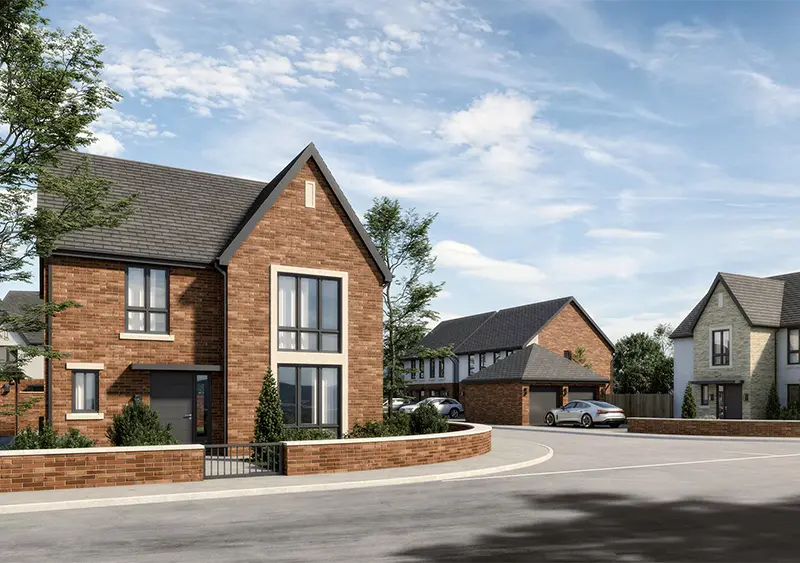CGI for Property Developers
Sell the dream before the deal.

6 MIN READ
July 10, 2025

Written By
Sasikumar Janakiraman
That’s why CGI matters. It turns the abstract into something people can connect with. You're not just tossing around blueprints; you're giving them a glimpse into a real space, fully fleshed out with light, texture, and even mood. It could be a cozy studio or a high-rise lobby. Doesn’t matter. Seeing it beats explaining it.
This piece walks through where CGI actually fits into a build. Not just at the end for ads but right from the start, when you're shaping the whole thing.
What is CGI?
CGI, or Computer-Generated Imagery, is the art of creating visual content using computer software. From still images to full animations, CGI brings ideas to life that are difficult or even impossible to capture with a camera.
You’ll find CGI in movies, television, architecture, advertising, and product design. It’s the tool filmmakers use to create imaginary worlds and the way designers present buildings before construction begins.
At its core, CGI relies on 3D modeling, texturing, lighting, and rendering. These elements come together to produce visuals that look realistic or stylized, depending on the creative direction.
How CGI Helps Throughout a Development Project?
A lot of folks think CGI only kicks in when it’s time to launch the website or slap something on a billboard. That’s a narrow view. The truth is, developers are tapping into CGI way earlier sometimes right after sketches are done.
Let’s break it into the stages where CGI really earns its keep:
1. Conceptual Planning & Local Approvals
Getting a real estate project approved involves multiple stakeholders: architects, planning boards, community councils, and government departments. All of them need to understand what’s being proposed, how it looks, how it fits into the environment, and how it impacts surroundings.
This is where CGI helps translate technical blueprints into digestible visuals. A 3D exterior render of the proposed structure, placed within a real-world streetscape, tells a far clearer story than lines on paper. These visuals also help mitigate concerns from local residents by showing how a project will look once completed, instead of leaving it up to imagination.
For large-scale developments, CGI can even support environmental reports, sun path studies, and traffic flow modeling ensuring smoother communication with planning authorities.
2. Pre-Sales & Off-Plan Marketing
With CGI, you can showcase the full experience before a single concrete pour. Potential buyers get to see kitchen finishes, bathroom layouts, balcony views, lighting conditions, and even decor options all through photorealistic renders or virtual walkthroughs.
This doesn’t just improve interest. It builds emotional connection. Buyers can imagine living there. That sense of familiarity increases their willingness to book or reserve units earlier, shortening your sales cycle significantly.
And because CGI is digital, it allows for variations. Want to show three different furniture options or wall colors? No problem. You don’t need to stage multiple model units CGI makes it easy to test and adapt.Just like digital catalogs do for growing eCommerce brands.
3. Investor Presentations & Fundraising
Whether you’re pitching to a private investor, a real estate fund, or a financial institution, numbers alone won’t seal the deal. Investors want to feel the vision and CGI helps you present that vision with clarity and confidence.
Instead of trying to explain the scope and scale of your project through spreadsheets and site maps, you can walk them through an immersive flythrough or render set. It shows that you’ve thought about the details: how the development sits on the land, what amenities will look like, how sunlight filters through common areas. These details matter.
A polished set of visuals instantly elevates your pitch deck. It sends the message that this is not just a concept, it’s a near-real product and that kind of confidence can accelerate funding discussions.
4. Lead Generation, Listings & Online Campaigns
Once construction begins and you enter the active selling phase, CGI becomes your main marketing asset. Developers no longer need to wait for show homes to be ready. You can launch your campaign as soon as the CGI suite is done.
High-quality 3D visuals can power your website, real estate portals, social ads, email campaigns, and even outdoor banners. They’re often more consistent and controllable than photography, allowing you to show every angle in perfect lighting.
And with interactive formats like 360° views or animated walkthroughs, buyers don’t just see the property they experience it. This is especially powerful for overseas clients or high-end buyers who expect a premium presentation.
The result? Higher engagement, better qualified leads, and faster closings.
Discover lifestyle CG storytelling tips to see how mood, character, and context bring architectural visuals to life.
Types of CGI Property Developers Use
CGI isn’t a one-size-fits-all solution. Different stages and goals call for different types of visuals. Here are the most commonly used formats and when they make sense:
Photorealistic Renders
These are still images that show a single perspective like a living room interior, building façade, or rooftop garden. When done well, they are nearly indistinguishable from real photos. Developers use these in brochures, listings, signage, and display boards.
3D Walkthrough Animations
An animated video that guides the viewer through the space, mimicking the experience of walking around the finished unit. It’s highly effective at sales launches, investor pitches, and project exhibitions. It also adds emotional movement, and music brings the space to life.
360° Virtual Tours
These allow users to click and drag their view in all directions, exploring each room at their own pace. Useful for websites, tablets in showrooms, or sharing via WhatsApp and email links. Especially handy for remote buyers.
Site Plan Overviews
Used in large developments, these visuals show the layout of all buildings, roads, parks, and communal areas in a single shot. It gives buyers a feel for orientation, spacing, and surroundings.
Why CGI Gives Property Developers a Competitive Edge?
The real power of CGI lies in its flexibility. Unlike photoshoots, you don’t need to wait. You don’t need props, lighting setups, or physical access. Once you have your designs, CGI can be built from your CAD files, floor plans, or even hand sketches.
And it isn’t static. Need to update kitchen finishes? Switch unit types? Add a logo to a hoarding? It’s all digital, so revisions are faster and cheaper.
More importantly, CGI helps you get ahead of the build. Instead of waiting for construction to catch up, your marketing, approvals, and sales can begin months earlier. That’s a serious advantage in a market where timelines and margins are tight.especially when you use 3D product modeling to accelerate eCommerce readiness.
Final Thoughts
CGI has become one of the most effective tools in a property developer’s arsenal. It speeds up sales, improves communication, and removes friction at every stage of the journey from idea to delivery. Whether you’re building ten homes or launching a luxury tower, the right visuals can help you move faster, pitch better, and sell smarter.
In today’s market, where buyers expect clarity and investors want proof, CGI doesn’t just enhance your pitch. It proves your vision.
Want your property to sell before the site is even cleared? ZealousXR crafts photorealistic CGI that turns concepts into conversions. From flythroughs to fully rendered exteriors, we help property developers build trust, attract leads, and speed up sales before construction begins.
About the writer :
Sasikumar Janakiraman, as the Creative Director at Zealous Services, brings a unique mix of creativity and technical ... skill. He’s passionate about 2D and 3D design, leading teams to create stunning 3D models and visualizations. Sasikumar loves working closely with clients, making sure their ideas come to life in the best possible way. His goal? To make design feel simple and exciting.
Read MoreFrequently Asked Questions (FAQ)
What is CGI in property development?
CGI (Computer-Generated Imagery) refers to 3D visuals used to represent a property before it’s built. Developers use it to show realistic interiors, exteriors, and site layouts for approvals, sales, and marketing.
How early can CGI be used in a project?
CGI can be introduced as early as the concept stage. Developers often use it for planning submissions, investor decks, and early off-plan marketing sometimes before construction even begins.
Is CGI better than traditional photography?
Yes, for unbuilt properties. Unlike photography, CGI doesn’t require a physical space. It allows developers to showcase future buildings with perfect lighting, decor, and angles long before anything is constructed.
What types of CGI are most useful for real estate?
Photorealistic stills, 3D walkthroughs, 360° virtual tours, and site-wide visuals are most commonly used. Each serves a different purpose—some for brochures, others for interactive buyer experiences or investor presentations.
Does CGI help sell properties faster?
Absolutely. High-quality CGI helps buyers visualize the space, builds trust, and generates leads early. Many developers see faster pre-sales and better engagement with CGI-driven campaigns